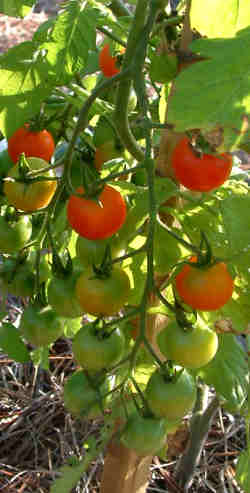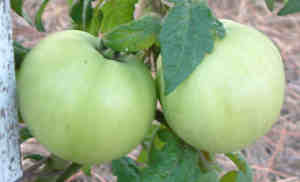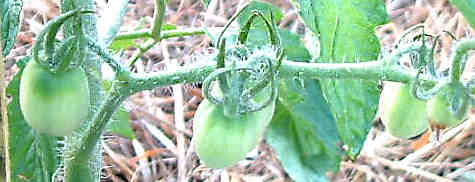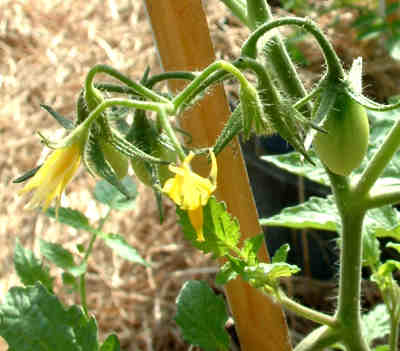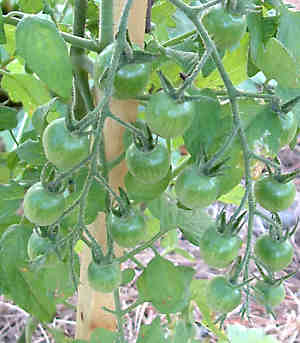Hybrid Tomatoes
Hybrid Tomato Experiment
This year in my tomato garden instead of growing heirloom tomatoes, I am growing all hybrid tomatoes. So why the change? It’s because I’m doing hybrid tomato experiment. Let’s see what’s going on.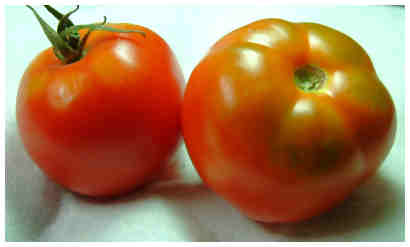
A Review of Hybrid Tomatoes
So what is a hybrid? A hybrid is a plant that has two different parents. For example one parent can be a red tomato and the other parent can be one colored yellow. In my particular case I have a tomato plants that had two very different parents. One parent was a white tomato, and the other parent was a red tomato.
How do I know this? It’s because I have a packet of seeds for a white determinate tomato, and from that packet I got a plant that was an indeterminate red tomato. This means that my red tomato was a hybrid. An accidental hybrid probably, but it’s a hybrid nonetheless.
The F1 Generation
That red tomato that grew from a packet of white tomato seeds, was an F1 hybrid. But what is an F1 hybrid? It’s the first generation from a cross between two different parent plants.
Since I grew out more seeds from that particular packet and I got white determinate tomatoes, I suspected that my red tomato was F1 hybrid. However, I would not know that until I planted seeds from those red tomatoes. (The photo is of two of the fruits off the F1 plant.)
This year I planted eight seeds from the red tomato plant. And what did I get? I’ve got both indeterminate and determinate plants. This means that my red tomato was indeed an F1 hybrid cross.
The F2 Generation
My eight little plants growing this year are the F2 generation. These are the progeny of my F1 plant. What can I expect to get? Determinate and indeterminate certainly, but what about tomato size and color? That’s where things get interesting.
When it comes to tomato genetics, the color red is dominant over any other color. This means that I will undoubtedly get red tomatoes, can I expect any other color?
It’s hard to say. I might get some white determinate tomatoes, but with only eight seeds planted the chances are slim. That isn’t to say that I won’t get lucky!
My F1 plant had red tomatoes that were been 3 and 5 ounces each in size. However the white determinate tomatoes that I planted, had fruit that were about 7 ounces each. My hope is that I can get some nice red tomatoes in the 6 ounce size range.
As for the determinate plants that I have growing, I expect they will be red. However, you never know what kind of colors might show up; after all, this is a hybrid! And I have no idea what that red tomato was crossed with. The only thing I know for sure is that it was a determinant.
So stay with me, and we’ll see what these plants turn out to be. But I’ll keep you posted through the growing season. It certainly will be an interesting hybrid experiment!
Tomato Red Bush – Who Are You?
I have a tomato I am calling Red Bush, for lack of a better name. I bought a pack of White Bush seeds from a major seed-seller (Johnny’s). I planted some of the seeds, and got a surprise.
Red Bush – Who Are You?
 When it comes to tomato colors, red is dominant over white. So my red tomato has to be a cross from White Bush and an unknown red tomato. Yes, it’s a hybrid tomato – the result of two different parents.
When it comes to tomato colors, red is dominant over white. So my red tomato has to be a cross from White Bush and an unknown red tomato. Yes, it’s a hybrid tomato – the result of two different parents.
Now there’s no telling what variety the red plant was, especially since these seeds are from an old packet. But it’s an excellent chance to experiment! You see, when I save the seeds and plant them, I should get several different kinds of tomato plants, with different kinds of tomatoes. Some should be red, some white, some who knows what — depends on who the red parent was and if it was a hybrid!
(As an aside, I have another tomato plant growing from the same packet, and it is indeed the variety White Bush.)
Saving Tomato Seeds
Now I’m torn — do I eat that first red tomato off that plant, or do I save the seeds? The answer is – both! Since I have one ripe and one almost ripe, I can start the seed-saving process with some from the first tomato. Then some more from the second.
Since I’m saving these seeds for my own use, I’ll save them on a paper towel. But if I was saving tomato seeds to give to another person, I’d use the normal process that gets rid of any unwanted pathogens.
Having an obvious cross like this tomato makes it quite interesting to see what grows out. And while it’s fairly unusual to get an obviously crossed tomato in a commercial seed packet, it’s fun when you do!
Tomato Red Bush – who are you, really? I may never know, but I sure will have fun with its “children”!
SuperSweet 100 Cherry Tomatoes
SuperSweet 100 cherry tomatoes are fun to grow. And what’s really nice is that the cherry tomatoes they produce are nice and true to their name – sweet!
A Little About SuperSweet 100
This particular tomato is an improved variety over Sweet 100. And supposedly a relative of Sweet Million. It’s a hybrid tomato, so plants grown from the seeds won’t necessarily breed true. Although I do believe I will try it anyway! I’m curious to see what I’ll get next season.
The SuperSweet 100 plant in the photo (and you can click the photo for a larger picture) has the cherry tomatoes just starting to turn red. It will be interesting to look at when more of the fruits start ripening.
This particular plant is a survivor! It’s made it through nights in the 30’s, being nibbled on by rabbits and being blown down in high winds. It’s also not growing in the best part of the garden, so it’s got a lot going against it. But it doesn’t seem to matter; it keeps putting out flowers, and nearly every blossom sets fruit.
SuperSweet 100 is an indeterminate plant with regular leaves.
Growing Cherry Tomatoes
One nice thing about the SuperSweet 100 is that it’s a cherry tomato of a perfect size for your mouth, at about 3/4″ to about 1″ in size. I have mine growing in the ground, but I think they’d grow fine in a large container on the patio. For a true bounty, I’d use a 10-gallon container.
You will need to stake this plant. Mine is on a 5.5′ stake, which would probably also be OK for a container. If it was in the good part of the garden, I’d rather use a 7′ stake.
SuperSweet 100 is a fantastic “garden candy” — great for popping in your mouth while working in the garden. Actually, so far this season, none of the ripe fruits have made it to the table — I’ve munched them while out in the yard. Soon enough, though, there will be plenty to eat outside and bring into the house for salads.
Hybrid Tomatoes, Part 2
I talked about hybrid tomatoes in part 1 of this post. Now that we’ve discussed the cherry varieties, let’s talk about how the slicer-size hybrids are doing in the garden.
Hybrid Tomatoes in the Garden
Just as a review, I have the following slicer-sized hybrid tomato plants in the garden:
- Celebrity Bush (determinate slicer)
- Fabulous (determinate slicer)
- Goliath Bush (determinate slicer)
- Park’s Whopper (indeterminate slicer)
All these plants have there own merits, but so far, Fabulous has been, well, fabulous! It’s by far the most vigorous, and has a nice, healthy growth, and regular leaves. I have it growing in a 5-gallon container, and it behaves as if it were in the ground – very lush and full of blossoms.
There aren’t any ripe tomatoes yet on Fabulous (darn!), but I’m looking forward to them. If they taste even half as good as the plant currently looks, it’s earned a continued spot in my garden.
And how have the others fared?
Bush Goliath has been the most prolific to date, and the tomatoes from one of the plants has been fairly good; the other one’s taste has been forgettable. Both plants currently have ripening tomatoes, so we’ll see how this batch does. Bush Goliath is a fairly small plant in my garden, at just 16 inches tall, with rugose leaves.
Celebrity Bush has had a hard time with the cold weather this year. While it’s normally quite productive, this season’s chillier-than-usual winter has taken its toll. It has come back some, now that the warm weather is here to stay. I’ll keep an eye on it. This plant is about 12 inches tall at the moment, and has rugose leaves.
Park’s Whopper currently has the best tasting fruit of the group. The winter has been hard on it as well, but it’s coming back and producing some nice tomatoes. Had a great one on a sandwich yesterday! The plant is now at 12 inches tall (the February frost nearly did the plant in totally), and has regular leaves.
Hybrid Tomatoes and the Garden
Hybrid tomatoes are deliberate crosses between two different tomato varieties. Hybrid tomato plants are often thought of as being more productive or disease resistant – but not as great tasting as heirloom tomatoes. Is that true? And how are these hybrid tomato plants doing in my garden?
Hybrid Tomato Varieties
Although I mostly grow heirloom or open-pollinated tomato varieties, I do grow some hybrids. I especially like some of the cherry tomatoes. Then of course I have to try something new every year — you never know when something will earn a continued spot in the garden.
This year, I am growing the following hybrid tomato plants:
- Celebrity Bush (determinate slicer)
- Fabulous (determinate slicer)
- Goliath Bush (determinate slicer)
- Juliet (cherry)
- Park’s Whopper (indeterminate slicer)
- Supersweet 100 (cherry)
- Tomatoberry (strawberry-shaped cherry)
So how have they been faring?
The Cherry Tomatoes Win for Productivity
That’s really no news, since cherry tomatoes are known for their prolific yields. But one variety in particular is amazing — Tomatoberry.
I bought Tomatoberry because the description sounded intriguing — a cherry tomato the size and shape of a strawberry. While I’m not sure that the fruits are really strawberry-shaped (although I do see a slight resemblance on some of the fruits), the plant is amazing!
I didn’t take a photo of the awesome flower sprays this plant has, and so far, pretty much each flower has set a fruit. So “prolific” is a little bit of an understatement. I’ll have to take a photo as the tomatoes start to turn red — that will be a sight! (I wish I had taken a better picture to show what the spays of tomatoes are like.)
Juliet bears some lovely fruit — it’s a grape cherry tomato. While setting on nearly every blossom, it’s not quite in Tomatoberry’s league. Then again, I am growing Juliet in 5-gallon containers! I imagine that Juliet would do far better in a larger container, or in the ground.
Supersweet 100 was the first of the cherry tomatoes to set fruit. Once again, pretty much every flower sets fruit. I have it growing in the ground, but it’s not in the best location — it only gets about 6 hours of sun a day.
It’s been nibbled by a bunny, blown down in a windstorm and I’ve not always been the best in watering that particular area. Still, this plant continues to grow and set fruit with abandon. I’d call it quite hardy in less-than-desireable conditions. I’ll have to grow one of these plants in the main garden that gets full sun one of these days. That should be a sight!
Well, this post is getting kind of long, so I’ll stop for now, and pick up later with the report on the slicer-sized hybrid tomato plants.
